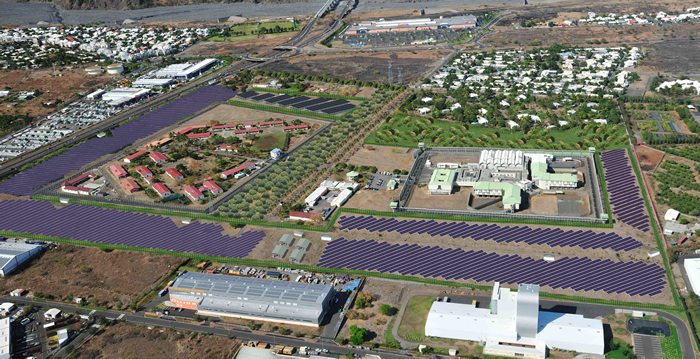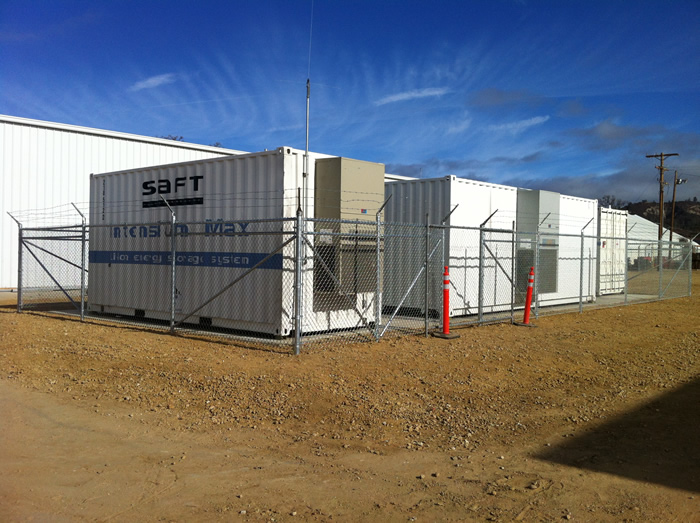Battery energy storage systems (ESSs) are becoming well established to help the grid integration of solar photovoltaic (PV) and wind energy, particularly in remote and island communities. It is important to understand the different roles that energy storage can play, including controlling ramp rates, smoothing, shaping, peak shaving and frequency regulation.
Optimising Energy Storage for Renewable Energy Security
Michael Lippert | Saft
Battery energy storage systems (ESSs) are becoming well established to help the grid integration of solar photovoltaic (PV) and wind energy, particularly in remote and island communities. It is important to understand the different roles that energy storage can play, including controlling ramp rates, smoothing, shaping, peak shaving and frequency regulation. It also important to appreciate how these different roles will affect the system’s performance and the size of ESS required. In this article we outline Saft’s approach to finding the optimum size of Lithium-ion (Li-ion) ESS for a particular installation, taking into account measured weather data, system modelling and the local regulatory regime so that renewable operators can optimise the whole life cost of their installation.
Renewable energy sources, including solar and wind power now generate 28 percent of the world’s electricity, up 3 percent since 2013. The UK alone has committed to producing 15 percent of its energy from renewable sources by 2020, however in order to meet this goal, over 30 percent of electricity must move to renewable production. In the run up to COP21, it is more important than ever to take into consideration the options for increasing sustainability and realising the imperative to do so in an efficient, stable way. Not only does renewable energy provide a key solution to combatting climate change, but through providing versatile options, renewable energy can also aid energy security through a more varied supply of electricity to the national grid.
While specific weather conditions can be difficult to predict - a primary issue is the effective storage of renewable energy. 42% of sunlight reaches the UK directly, meaning that at certain times, solar energy reaches panels efficiently, yet cloud cover and other factors can interrupt consistent power generation. Another factor is the fact that the most ideal sites for generating renewable energy include exposed windy areas, hilltops, by the coast or out at sea, meaning they are often far away from existing grid infrastructure, which conventionally connects industry and cities. When they are connected to the national grid, other issues arise, including grid stability challenges, congestion and saturation due to the unpredictable flow of weather-dependent renewable power. In order to combat these challenges, a number of energy storage solutions (ESS) can be used in order to meet specific grid requirements and secure a dependable energy forecast.
Smoothing output and controlling ramp rate
To mitigate changes in energy production from sudden fluctuations in output from cloud cover or a shift in wind speed, ramp rate control is required. This stores or releases energy in line with power variations. Ramp rate control acts as a buffer to smooth production levels over sudden fluctuations in productivity. This means that the grid receives a controlled output, with production remaining in the predefined forecast window.
Smoothing functions perform in a similar way to ramp rate control, by keeping production within a given forecast window. Smoothing works by utilising the power generated at peak times in order to fully charge the battery, allowing dependable functionality throughout a 24-hour cycle. This makes it easier for the grid operator to establish power predictions to maintain a safe supply of energy. In this way, the ESS is able to compensate for short-term power sags.
Shaping and shaving power for grid reliability
Alternatively, power shaping functions work by releasing a large discharge in the morning before the sun reaches optimum positioning. The ESS will then charge during peak daylight hours around midday before discharging again at sunset. This maintains a steady, predictable flow of energy, with a Depth Of Discharge (DOD) of around 70 percent, a significantly higher discharge than an ESS used for ramp rate control.
When used for peak shaving, an ESS can provide power to help reduce the load on the grid during periods of peak demand. Also, when generation is at a peak the ESS can store the excess generation, helping to avoid revenue loss through curtailment.
Regulating frequency leading to increased renewable connectivity
An ESS can also perform a key role in the frequency regulation essential to maintain the grid frequency within preset operational limits. In the past generating assets have been brought online at short notice, with a fast response within up to 30 seconds required to maintain stability. An ESS can play an enhanced role due to its capability to either inject or absorb power into or from the grid. Through using an ESS in this way, the grid is able to accommodate more solar and wind plants.
The operation profile of the ESS hence depends on the number and amplitude of frequency deviations of a given electricity grid or area. Usually, deviations are of a short duration and rarely reach full amplitude. Subsequently, a frequency regulation ESS works in a similar way to ramp rate control, requiring many small charge and discharge operations throughout the day.
Developing an effective energy management strategy
Each of these technologies helps to highlight the need for a tailored ESS depending on the requirements of particular grids and processing facilities. When considered a part of an entire system rather than a standalone unit, experience has shown the benefits of implementing a tailored ESS in line with specific needs and requirements. When considering whole life cost of an ESS, a number of factors come into play, including physical, operative and legislative considerations. The whole life cost of the system is made up of its capital cost, maintenance cost and operational costs, alongside the cost of curtailments or outages.
The process to select an optimal ESS is primarily based around an Energy Management Strategy (EMS) for any solar or wind plant. Knowledge of a customer’s requirements, local legislation and the profile of the plant - all site specific- are all taken into consideration during the selection process. To collect this information, the actual solar profile or wind should be measured over several days or months. This is performed site to site in order to take into account local geography and variability in order to match an optimal ESS. The customer must also communicate their specific objectives in terms of power output. Once this information is obtained, Saft can apply its industry expertise to specify the system including energy, charge and discharge power capacities and the effect of aging processes.
When combined, this information will determine how the plant should be operated in order to optimise operating revenues and penalties to balance lifetime costs, asset lifetime, CAPEX and OPEX.
Predictive modelling to optimise cost
Once an EMS is in place, the next step is to carry out modelling to determine the optimum size of ESS. This is an iterative process. Firstly, battery specification is estimated and combined with its other parameters alongside other inputs into the EMS. The model then mimics the performance of the ESS down to the level of individual cells. The model registers projected electrical and thermal performance while considering the aging of cells. These procedures run the same algorithms as battery management systems in the field, meaning that the results provided are reliable and accurate to a professional industry standard.
The modelling software allows engineers to make key insights into the battery’s behaviour in a wide range of situations. This acts to highlight opportunities to increase efficiency or performance based upon the findings from modelling procedures. Costs are then formulated based on the best or most efficient operational scenario while considering installation alongside whole life function.
Lessons from the experts
Modelling was successfully brought into practice for an ambitious project- Saft’s largest to date - at La Reunion, a small island in the Indian Ocean, where a 9 MWp PV plant has been installed. Located in Bardzour, the requirements were to provide a power shaping ESS in order to inject power into the grid at a constant 40 percent of the plant’s peak power capacity. Through modelling, Saft identified the optimum ESS as a 9 MWh Intensium® Max+ 20E containerised Li-ion battery system. This provided the most cost effective solution for the end user’s requirements, while ensuring a long and dependable lifespan.


Saft has currently delivered in excess of a total 80 MW of large-scale Li-ion battery-based ESS. This has contributed to a body of knowledge that has enabled Saft to develop as deep understanding of factors that contribute to high performance and a long, sustainable service life.
The content & opinions in this article are the author’s and do not necessarily represent the views of AltEnergyMag
Comments (0)
This post does not have any comments. Be the first to leave a comment below.
Featured Product

